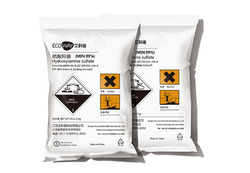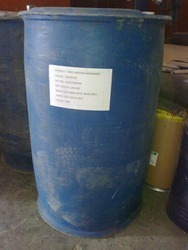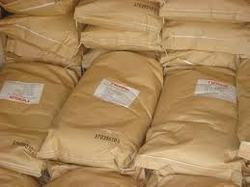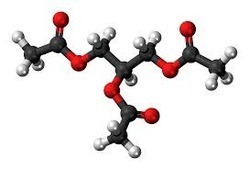Hydroxylammonium sulfate
Price 3625 INR/ Bag
Hydroxylammonium sulfate Specification
- Usage
- Laboratory reagent, intermediate for dyes and pharmaceuticals
- CAS No
- 10039-54-0
- Molecular Weight
- 164.14 g/mol
- Appearance
- White crystalline powder
- Application
- Pharmaceuticals, chemical synthesis, reducing agent, photographic industry
- Structural Formula
- (NH2OH)2H2SO4
- Taste
- Odorless
- Molecular Formula
- NH2OHH2SO4
- Density
- 1.89 Gram per cubic centimeter(g/cm3)
- Shape
- Crystalline solid
- Melting Point
- 170C (decomposes)
- HS Code
- 2826
- Shelf Life
- 2 years
- Solubility
- Soluble in water
- Poisonous
- YES
- Ingredients
- Hydroxylammonium sulfate
- Product Type
- Inorganic Salt
- Grade
- Industrial Grade
- EINECS No
- 233-118-8
- Properties
- Stable under normal conditions, decomposes on heating, strong reducing agent
- Smell
- Odorless
- Purity
- 99%
- Storage
- Store in a cool, dry place away from incompatible substances
- Ph Level
- 3.0 - 4.5 (50g/l, H2O, 20C)
- Physical Form
- Powder
Hydroxylammonium sulfate Trade Information
- Minimum Order Quantity
- 10 Bags
- Payment Terms
- Letter of Credit (L/C), Paypal, Western Union, Cash in Advance (CID), Cash Advance (CA)
- Supply Ability
- 100 Bags Per Week
- Delivery Time
- 7 Days
- Sample Available
- Yes
- Sample Policy
- Sample costs shipping and taxes has to be paid by the buyer
- Main Export Market(s)
- Western Europe, Australia, South America, Eastern Europe, Middle East, Central America, Asia, North America, Africa
- Main Domestic Market
- All India
About Hydroxylammonium sulfate
Hydroxyl Amine Sulphate
"This particular price varies on daily basis. Please call and check for the latest price"
Specification:
| Parameter | Specification |
| Hydroxylamine Sulphate | Min.99.0% |
| Amine Sclphate | Max.1.0% |
| Chloride | Max.0.0002% |
| Iron | Max.0.0003% |
| Heavy Metals | Max.0.0001% |
Key Features and Composition
Hydroxylammonium sulfate features high purity (99%) and exists as a white, odorless crystalline powder. With a density of 1.89 g/cm, it boasts excellent solubility in water and serves as a strong reducing agent across various industrial applications. Its molecular formula is NH2OHH2SO4, and it maintains stability under normal conditions when stored and handled correctly.
Safe Handling and Storage Guidelines
Given its classification as Class 8 (corrosive) and its toxic nature, Hydroxylammonium sulfate demands careful attention. It should be stored in a cool, dry area, away from strong oxidizing agents and bases, within the 530C range to preserve stability. Proper PPE and storage practices minimize risk and extend shelf life up to two years.
Industrial and Laboratory Applications
Widely utilized as a laboratory reagent and an intermediate in pharmaceutical and dye synthesis, Hydroxylammonium sulfate also plays a vital role in the photographic industry. Its reducing capabilities are leveraged in numerous chemical reactions and processes, adding value across diverse sectors.
FAQs of Hydroxylammonium sulfate:
Q: How should Hydroxylammonium sulfate be safely stored?
A: Store Hydroxylammonium sulfate in a cool, dry location away from incompatible materials like strong oxidizers and bases. Ensure the temperature remains between 5C and 30C, and use original sealed packaging, such as 25 kg bags or drums, to preserve product integrity.Q: What precautions are necessary when handling Hydroxylammonium sulfate?
A: Always wear appropriate personal protective equipment, including gloves and safety goggles. Avoid inhalation, ingestion, and contact with skin, as this substance is corrosive and toxic. Use it only in well-ventilated areas, following standard chemical safety protocols.Q: Where is Hydroxylammonium sulfate mainly used?
A: It is predominantly applied in chemical synthesis, as an intermediate for dye and pharmaceutical production, and in laboratory research. The compound also finds use in photographic processing due to its reducing properties.Q: What are the benefits of using Hydroxylammonium sulfate in industry?
A: Hydroxylammonium sulfate offers strong reducing power, high purity, and versatility, enabling its use in various chemical reactions. These qualities make it valuable for manufacturing dyes, pharmaceuticals, and specialty chemicals, contributing to efficiency and product quality.Q: When does Hydroxylammonium sulfate decompose, and what should be avoided?
A: It decomposes before boiling and at temperatures above its melting point (170C). Consequently, avoid heating the compound and keep it away from strong oxidizing agents and bases to prevent hazardous reactions.Q: How can Hydroxylammonium sulfate be disposed of after use?
A: Dispose of unused material in accordance with local hazardous waste regulations. Consult your facilitys guidelines or a waste disposal professional, as improper handling poses environmental and safety risks.

Price:
- 50
- 100
- 200
- 250
- 500
- 1000+
More Products in Industrial Products Category
Dimethylamine
Price 60 INR / Kilograms
Minimum Order Quantity : 25 Kilograms
Physical Form : Other, Gas or Aqueous Solution
Appearance : Colorless Gas or Clear Aqueous Solution
Refractive Rate : Not applicable for gas; Aqueous solution ~1.37
Usage : Chemical synthesis, water treatment, rubber vulcanization
Vinyl Acetate Monomer (VAM)
Price 17250 INR
Minimum Order Quantity : 1 Dram
Physical Form : Liquid
Appearance : Clear, colorless liquid
Refractive Rate : 1.395
Usage : Raw material for polymerization and copolymerization
Paraformaldehyde Chemical
Price 1650 INR
Minimum Order Quantity : 10 Bags
Physical Form : Powder
Appearance : White powder or crystalline solid
Refractive Rate : Not applicable / Data not available
Usage : Used as a source of formaldehyde in chemical industry, laboratory reagent, and for disinfecting
Triacetin
Price 105 INR
Minimum Order Quantity : 25 Kilograms
Physical Form : Liquid
Appearance : Clear, transparent liquid
Refractive Rate : 1.4301.433
Usage : Plasticizer in plastics, food industries, pharmaceutical formulations
 English
English Spanish
Spanish French
French German
German Italian
Italian Chinese (Simplified)
Chinese (Simplified) Japanese
Japanese Korean
Korean Arabic
Arabic Portuguese
Portuguese Send Inquiry
Send Inquiry




 Send Inquiry
Send Inquiry Send SMS
Send SMS
